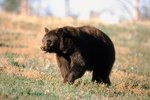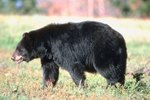Hibernation is a physiological state characterized by a deep sleep and dramatically reduced body temperature in mammals. It may last from a few weeks to several months, although, in the latter case, most animals wake up periodically. It is an adaptation to cold climates and occurs in winter.
Benefits
Some warm-blooded animals would be incapable of surviving cold winters. Low temperatures increase the amount of energy necessary to maintain body temperature, while at the same time making energy sources (food) scarcer. Hibernation is a solution to this problem. A hibernating animal keeps its body temperature only a few degrees above the external temperature and is virtually motionless. This causes its metabolism to slow down and thus spend much less energy than if the animal were awake. For this reason, a hibernating animals can survive the winter with virtually no food.
Process
At the start of hibernation, the body thermostat changes its value, causing a gradual decrease in body temperature and metabolic rate. After the desired values have been reached, the organism remains in a steady state, the duration of which can vary. When the animal is about to wake up, the thermostat returns to normal and the metabolic rate increases dramatically to well above the normal levels to reach the desired temperature rapidly. Once this goal is reached, it returns to normal. Because of this, waking up is generally much faster than entering hibernation. For example, it takes the ground squirrel between 12 and 18 hours to reach the dormant state but less than three to wake up.
Who Hibernates?
Most, if not all, hibernating animals are medium-sized mammals, such as bats and rodents. Neither small nor large mammals undergo true hibernation. Thus, the popular option of a hibernating bear is actually inaccurate from a biological point of view.
Large Animals
Large mammals, such as bears, do not need to hibernate because they can store enough fat for their winter needs. In addition, reheating their large bodies at the end of a hibernating period would take too much time and be costly in terms of the energy required. For these reasons, they undergo what is called “winter sleep,” which differs from hibernation because their body temperature is only slightly lower than normal. This allows them to wake up and become active in a relatively short time.
Small Animals
At the other end of the spectrum, small animals are unable to store enough reserves to allow them to hibernate. They need to obtain food daily or the reserves will run out, causing death. For this reason, small mammals and birds undergo what is known as “torpor.” This state is characterized by a profound decrease in body temperature, but differs from hibernation because this reduction is short. Typically, it lasts only a few hours. Because of their small size, they can restore their body temperature to normal fast and do so using a relatively small amount of energy. Examples of animals that undergo torpor are many hummingbirds and shrews.
References
- Eckert Animal Physiology: Mechanisms and Adaptations; David Randall; 1997
Writer Bio
Joao Ubeda is a freelance writer who also has a full-time job as a scientist in the life sciences. He holds a Ph.D in physiology from the University of Sao Paulo (Brazil) and started writing for Demand Studios in June of 2009, and his articles have appeared in eHow.





